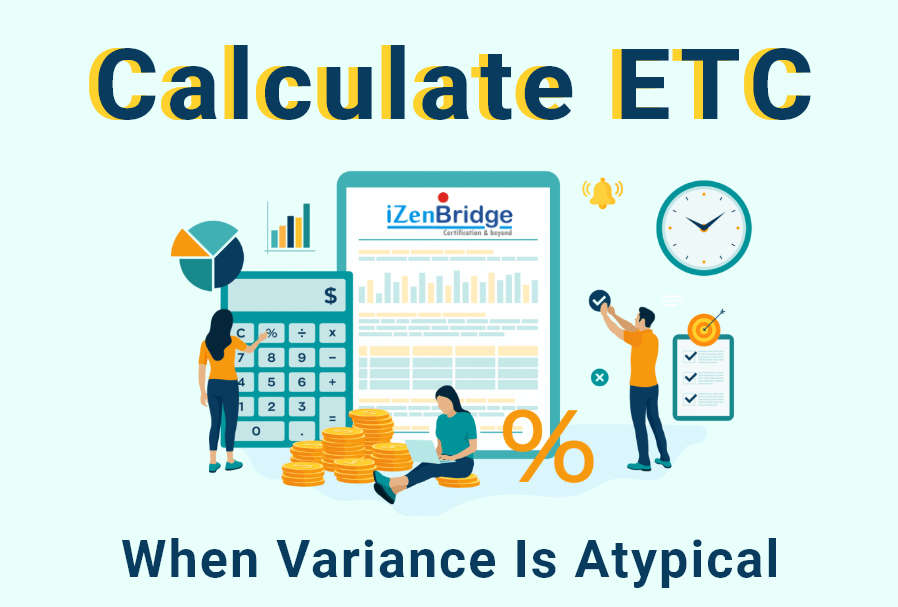

When we evaluate our project performance we need to also forecast how much more money is needed in this project and what could be the revised budget. Cost forecasts is a very important topic from PMP® exam point. Revised budget is nothing but EAC (Estimate At Completion) which will be different from initial planned numbers i.e. BAC (Budget at completion). EAC and ETC (Estimate To Complete) can be calculated in different ways depending on the reason of variations. In this blog, I’m going to discuss one of its variant that is Atypical.
Before we get into details of this blog, I just want to ensure that you have good understanding of what is EAC and ETC. You may like to give quick recap of my blog, ‘What is EAC & ETC and What are its Variants?’
Now let’s come to the variant Atypical or as defined in PMBOK® Guide EAC forecast for ETC work performed at the budgeted rate. As per PMBOK® Guide
This EAC method accepts the actual project performance to date (whether favorable or unfavorable) as represented by the actual costs, and predicts that all future ETC work will be accomplished at the budgeted rate. When actual performance is unfavorable, the assumption that future performance will improve should be accepted only when supported by project risk analysis
In other words, atypical means, the variation which has occurred or observed was one off variation and it is NOT going to continue further. Project, from this point on-wards can progress at budgeted rate.
Let’s take an example and try to understand and discuss on atypical variant of EAC and ETC. Let’s assume a Movers & Packers company took a project of shifting stuff from one place to another. Full project is planned for 5 hours as below:
There are total 4 activities booking, loading, unloading and completion & handover. Booking need 1 person for first hour and will cost 1K, loading needs 5 persons for 2 hours so planned to cost 10000, Unloading needs 5 persons for 1 hour so planned to cost 5000 and completion and handover needs 1 person for one hour so planned to take 1000. On the basis of this we have BAC planned to be 17000 at the end of 5th hour
Let’s access the situation at the end of 2nd hour of work. We have observed some variation to our plan as below:
The variation we faced in above example is “labor not available”. As we are discussing atypical scenario, we are sure that current variation was only for first 2 hours e.g. there was some local festival rituals in the morning, going further it won’t be there, it was a one time or Atypical in nature. Rest of the work (ETC) will be done at budgeted rate. In this case we can calculate EAC as
So we have considered the variations which has happened already in terms of AC and added the remaining worth of work to forecast the revised budget. It’s very important to understand that if we have not faced any variations and we are going as per plan, AC = EV. In that case,
You may wonder what to do if my current variants are not atypical? Yes, we have other ways of calculating ETC.
In a difference scenario when we observe the current variance are the typical one, mean we are going to observe similar cost overrun or under run in coming days, we need to factor the variance in initial budget by way of adjusting budget based on variance for remaining duration, for more details check our blogs on ‘How to Calculate EAC & ETC with Typical CPI Trend?’ And, ‘How to Calculate EAC & ETC with Typical SPI & CPI Trends?’
There could be a case where you find the initial estimate of the project having errors and these errors cannot be just fixed by taking into account the current variances.
By now, you must have clearly understood How To Calculate ETC When Variance Is Atypical. For further questions and doubts on the subject, drop us a comment on our Discussion Forum. You can also log into our YouTube channel watch the videos on the related topics.
Enroll to our FREE PMP® Introductory Program to learn more about PMP® certification.
| Name | Date | Place | – |
| PMP Certification and Training | 18 Apr – 17 May 2024 | Pune | More Details |
| PMP Certification and Training | 4 May – 2 June 2024 | Chennai | More Details |